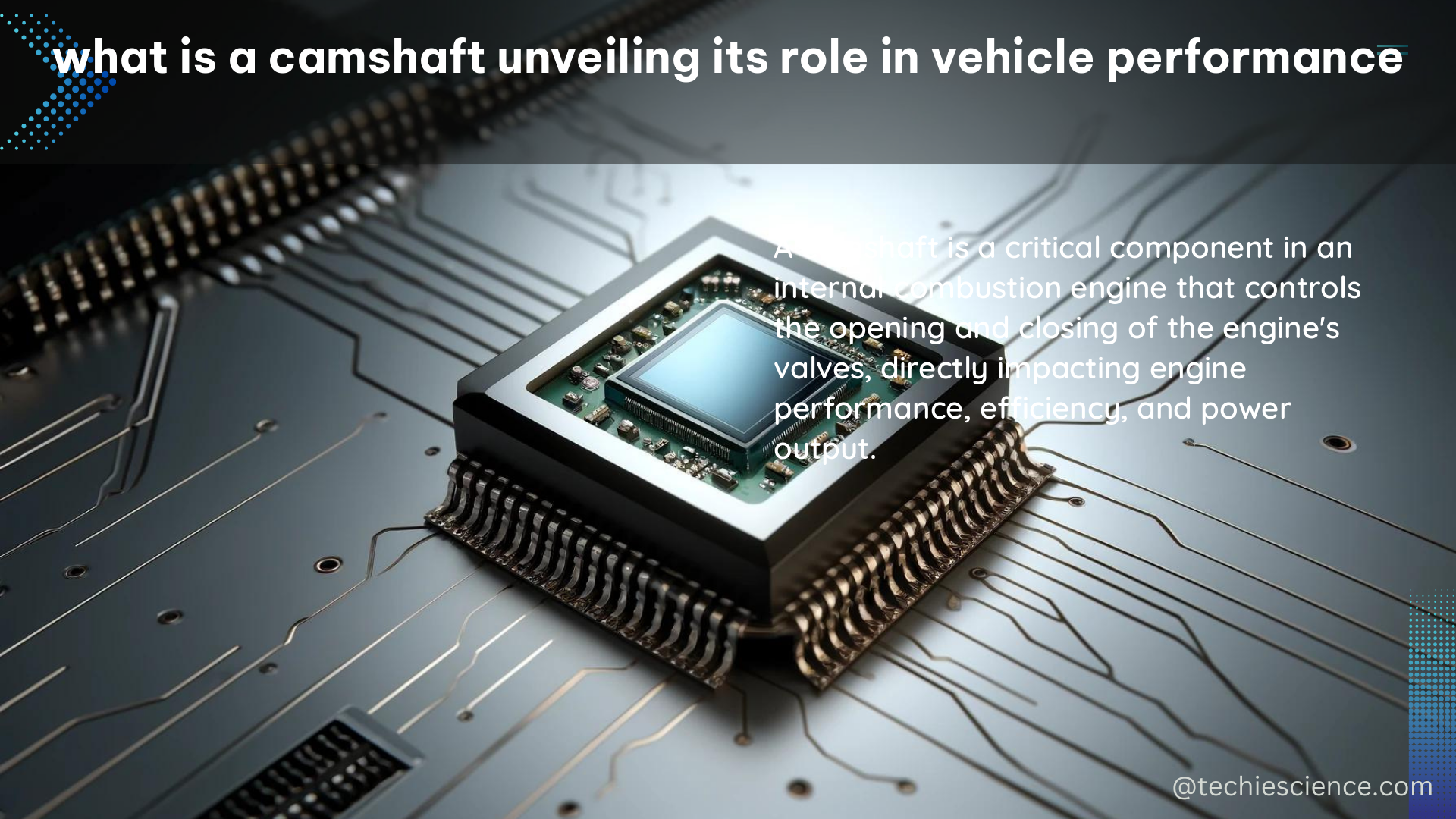The camshaft is a critical component in internal combustion engines, responsible for precisely controlling the opening and closing of the intake and exhaust valves. Its design, timing, and functionality significantly impact an engine’s performance, affecting crucial factors such as horsepower, torque, and emissions. This comprehensive guide delves into the intricate role of the camshaft, unveiling its significance in vehicle performance.
Understanding the Camshaft’s Anatomy and Function
The camshaft is a cylindrical rod that runs the length of the cylinder bank, with oblong lobes or cams protruding from it, one for each valve. These cams push against the engine’s intake and exhaust valves, opening them to allow the air-fuel mixture into the combustion chambers and expelling the exhaust gases.
The camshaft’s design is crucial, as the shape and profile of the lobes directly influence the timing and duration of valve lift events. Typical camshaft lobe profiles include:
- Flat-tappet Camshafts: These have a simple, rounded lobe shape that provides a moderate valve lift and duration.
- Hydraulic Roller Camshafts: These feature a more aggressive lobe profile, enabling higher valve lift and duration, resulting in increased engine power and efficiency.
- Mechanical Roller Camshafts: These offer even more aggressive lobe profiles, allowing for maximum valve lift and duration, further enhancing engine performance.
The camshaft’s timing, which refers to the precise moment when the valves open and close, is also critical. Proper timing ensures the efficient flow of the air-fuel mixture and exhaust gases, optimizing the engine’s power output and efficiency.
Camshaft Configurations and Their Impact on Performance

Modern engines can have various camshaft configurations, each with its own advantages and trade-offs:
- Single Overhead Cam (SOHC): In this configuration, a single camshaft operates both the intake and exhaust valves. SOHC engines are generally more compact and cost-effective, but they offer less precise valve control compared to dual overhead cam (DOHC) designs.
- Dual Overhead Cam (DOHC): DOHC engines have two camshafts, one for the intake valves and one for the exhaust valves. This design provides more precise control over valve timing and lift, resulting in improved engine performance and efficiency.
- Variable Valve Timing (VVT): VVT systems, such as Variable Valve Lift (VVL) and Variable Valve Timing and Lift (VVTL), allow the engine’s computer to dynamically adjust the timing and lift of the intake and exhaust valves based on engine speed and load. This flexibility enables the engine to deliver high torque at low RPMs and high horsepower at high RPMs, improving overall efficiency and reducing emissions.
The choice of camshaft configuration is a delicate balance between performance, efficiency, and cost, with DOHC and VVT systems generally offering superior engine performance at the expense of increased complexity and cost.
Diagnosing and Maintaining Camshaft Issues
Proper camshaft maintenance is crucial for maintaining optimal engine performance and longevity. Camshaft-related issues can be complex and may not always be easily detected through diagnostic tools alone. Some common camshaft problems include:
- Camshaft Wear: Over time, the camshaft lobes and their corresponding valve train components can experience wear, leading to reduced valve lift and timing accuracy, ultimately impacting engine performance.
- Timing Chain/Belt Failure: The camshaft is driven by the engine’s timing chain or belt, and if these components fail, it can result in severe engine damage.
- Camshaft Position Sensor Failure: The camshaft position sensor provides critical information to the engine’s computer about the camshaft’s position and timing. A faulty sensor can cause drivability issues and trigger check engine lights.
Diagnosing camshaft problems may require a combination of visual inspection, physical measurements, and the use of advanced diagnostic tools, such as OBDeleven NextGen. This tool can provide accurate trouble codes and real-time data to help identify potential issues and guide the necessary repair or maintenance steps.
Regular maintenance, including timely replacement of timing chains/belts and monitoring for signs of camshaft wear, is essential to ensure the camshaft’s optimal performance and longevity.
The Camshaft’s Role in Enhancing Engine Performance
The camshaft’s design, timing, and proper functioning are crucial in determining an engine’s overall performance and efficiency. By precisely controlling the opening and closing of the intake and exhaust valves, the camshaft directly influences:
- Horsepower: The camshaft’s ability to maximize valve lift and duration directly impacts the engine’s volumetric efficiency, allowing for greater air and fuel flow, resulting in increased horsepower output.
- Torque: The camshaft’s timing and valve lift characteristics play a significant role in the engine’s low-end torque production, which is essential for acceleration and towing capabilities.
- Emissions: The camshaft’s precise control over valve timing and lift helps optimize the air-fuel mixture and combustion process, reducing harmful exhaust emissions and improving the engine’s environmental impact.
Furthermore, the integration of advanced technologies, such as Variable Valve Timing (VVT), allows the engine’s computer to dynamically adjust the camshaft’s timing and lift based on operating conditions, further enhancing performance, fuel efficiency, and emissions control.
In conclusion, the camshaft is a hidden powerhouse that drives the performance and efficiency of internal combustion engines. Its intricate design, precise timing, and proper maintenance are essential for maximizing an engine’s potential, delivering the desired balance of power, torque, and environmental responsibility.
References:
– The Hidden Powerhouse: How the Camshaft Drives Engine Performance
– Student Guide for Performance-Based Service Acquisition (PBSA)
– SPCH-1113 Speech & Communication

The lambdageeks.com Core SME Team is a group of experienced subject matter experts from diverse scientific and technical fields including Physics, Chemistry, Technology,Electronics & Electrical Engineering, Automotive, Mechanical Engineering. Our team collaborates to create high-quality, well-researched articles on a wide range of science and technology topics for the lambdageeks.com website.
All Our Senior SME are having more than 7 Years of experience in the respective fields . They are either Working Industry Professionals or assocaited With different Universities. Refer Our Authors Page to get to know About our Core SMEs.